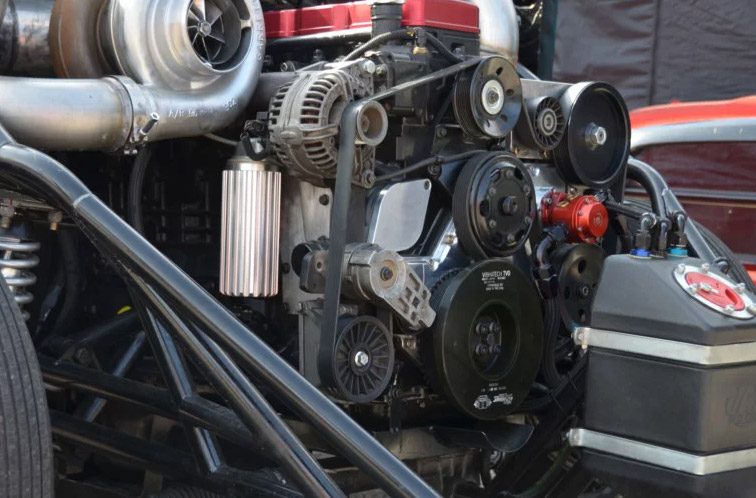In the high-octane world of racing cars, where precision and power are paramount, every component plays a crucial role in achieving optimal performance. Among these, the harmonic balancer stands out as a silent hero, ensuring the engine operates with unparalleled smoothness and efficiency. In this in-depth exploration, we’ll delve into the intricacies of harmonic balancers for racing cars, understanding their significance, functionality, and the impact they have on pushing the boundaries of speed and endurance.
Understanding the Basics

Harmonic balancers, also known as crankshaft dampers or vibration dampers, are essential components of a racing car’s engine system. Their primary purpose is to address the torsional vibrations generated by the engine during its operation. Torsional vibrations are oscillations or twists in the crankshaft, caused by the intermittent combustion cycles in the engine. These vibrations, if left unchecked, can lead to significant damage to engine components, affecting overall performance and longevity.
The Construction of a Harmonic Balancer
A racing harmonic balancer is typically composed of two main elements: the hub and the outer ring. The hub connects directly to the crankshaft, while the outer ring is attached to the pulley system, including accessories like the serpentine belt. Sandwiched between these components is a layer of rubber or elastomer, which serves as the crucial damping material.
The Science of Damping
Damping is the process by which harmonic balancers absorb and dissipate vibrations, preventing them from reverberating through the engine. The elastomer within the harmonic balancer acts as a shock absorber, absorbing the torsional vibrations and transforming them into heat. This process significantly reduces stress on the engine components and enhances overall stability.
Significance in Racing Cars

In the realm of racing cars, where precision and speed are everything, a racing harmonic balancer plays a pivotal role in optimizing engine performance. Here are some key aspects that highlight their significance in racing:
Reducing Vibrations for Increased Power
Racing engines are finely tuned machines designed to extract maximum power from every combustion cycle. Torsional vibrations can interfere with this process, leading to power losses and potential damage. Harmonic balancers ensure that the engine operates smoothly, allowing for more efficient power delivery to the wheels.
Enhancing Engine Longevity
The extreme conditions of racing put tremendous strain on engine components. Harmonic balancers contribute to the longevity of the engine by minimizing wear and tear caused by vibrations. This is particularly crucial in endurance races where engines are subjected to prolonged stress.
Maintaining Stability at High RPMs
Racing cars often operate at high RPMs (revolutions per minute), where the potential for vibrations is significantly increased. Harmonic balancers help maintain stability, preventing issues like misalignment and belt slippage that can arise at these elevated RPM levels.
Optimizing Pulley System Performance
The pulley system in a racing car is responsible for driving various accessories, such as the alternator and water pump. Harmonic balancers ensure that the pulley system operates smoothly, reducing the risk of component failure and maintaining consistent performance.
Customization for Racing Applications
In the competitive world of racing, where every fraction of a second counts, harmonic balancers are often customized to meet the specific demands of different racing applications. This can include variations in size, materials, and damping characteristics tailored to the unique requirements of the racing car.
Advanced Materials and Technologies
As racing technology evolves, so do the materials and technologies used in the construction of harmonic balancers. Racing enthusiasts and teams often turn to advanced materials such as carbon fibre and lightweight alloys to create balancers that are not only efficient in damping vibrations but also contribute to the overall weight reduction of the vehicle.
Additionally, advancements in elastomer technology have led to the development of high-performance damping materials that offer improved durability and temperature resistance. These innovations allow harmonic balancers to withstand the extreme conditions encountered in racing, ensuring consistent performance throughout the rigours of a race.
The Future of Harmonic Balancers in Racing

Looking ahead, the future of harmonic balancers in racing cars is likely to involve further refinement and customization. As racing technology continues to push the boundaries of speed and efficiency, harmonic balancers will be subjected to even greater demands. This may lead to the incorporation of smart technologies, such as sensors and real-time monitoring systems, to provide instant feedback on the condition and performance of the harmonic balancer during races.
Moreover, the quest for sustainability in racing may drive the development of harmonic balancers that not only enhance performance but also contribute to fuel efficiency and reduced emissions. This could involve exploring alternative materials and design approaches to create harmonic balancers that align with the evolving environmental consciousness of the racing industry.
Conclusion
In the adrenaline-fueled world of racing cars, where every component is meticulously designed for peak performance, harmonic balancers stand as unsung heroes. Their role in mitigating vibrations, optimizing power delivery, and ensuring the longevity of the engine is instrumental in the success of racing teams. As technology advances and racing enthusiasts continue to seek new frontiers, harmonic balancers will evolve, embracing innovations that redefine the limits of speed and endurance on the racetrack.
